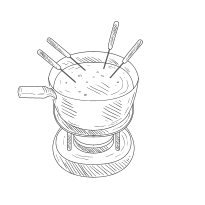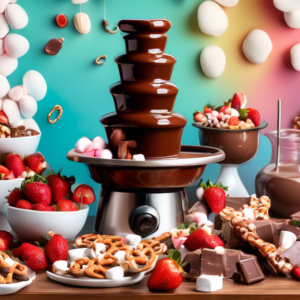Introduction
A chocolate fountain is a centerpiece that turns any ordinary gathering into a luxurious affair. The sight of cascading, velvety chocolate is simply irresistible, promising a delightful treat for all. But to truly elevate your chocolate fountain experience, using the right chocolate is paramount. Store-bought chocolate fountain melts often lack the nuanced flavor and texture of homemade chocolate. This comprehensive guide will unveil the secrets to crafting the perfect chocolate for your chocolate fountain, ensuring a symphony of flavors and a truly unforgettable experience.
Why Make Your Own Chocolate Fountain Chocolate?
While the convenience of pre-made chocolate melts is undeniable, crafting your own chocolate fountain concoction offers a plethora of benefits:
- Unparalleled Flavor: Unleash your inner chocolatier and customize the flavor profile to perfection. Experiment with different cocoa varieties, sugar levels, and additional flavors to create a taste that speaks to your soul.
- Superior Texture: Achieving the ideal viscosity is crucial for a smooth, flowing cascade. Homemade chocolate allows you to control the ingredients, ensuring a silky texture that gracefully coats fruits, marshmallows, and other delectable dippers.
- Cost-Effectiveness: Creating a large batch of chocolate for your fountain at home can be more economical, especially when catering to a crowd.
- Creative Freedom: Let your imagination run wild! Infuse your chocolate with hints of spices, extracts, or liqueurs to create signature blends that leave a lasting impression on your guests.
Understanding the Essentials: Chocolate for Fountains
Before embarking on your chocolate-making adventure, it’s crucial to understand the properties that make chocolate suitable for a fountain:
1. Type of Chocolate
Not all chocolate is created equal, especially when it comes to fountains. The ideal chocolate for a fountain should possess a high fat content to ensure smooth flowing. Here’s a breakdown of commonly used chocolate types:
- Couverture Chocolate: The gold standard for chocolate fountains, couverture chocolate boasts a high cocoa butter content (32-39%), resulting in superior fluidity and a luxurious mouthfeel. It comes in various types, including dark, milk, and white, allowing for diverse flavor profiles.
- Chocolate Chips: While convenient, chocolate chips are not ideal for fountains. They contain less cocoa butter and often include stabilizers that can hinder smooth flow. If using chocolate chips, opt for high-quality ones with a higher cocoa butter content and no added stabilizers.
- Candy Melts/Bark Coating: These are specifically designed for dipping and coating and are readily available in various colors and flavors. However, they typically contain vegetable oils instead of cocoa butter, which can affect the taste and texture. While they can be used in a pinch, they may not provide the same luxurious experience as couverture chocolate.
2. Cocoa Butter: The Secret to Smooth Flow
Cocoa butter is the natural fat found in cocoa beans, and it plays a vital role in achieving the perfect flow in a chocolate fountain. Higher cocoa butter content translates to a thinner consistency when melted, ensuring the chocolate cascades beautifully without clumping or solidifying too quickly. If you find your chocolate too thick, you can add more cocoa butter in small increments (about 1 tablespoon at a time) to achieve the desired consistency.
3. Sweetness Level: Finding the Right Balance
The sweetness of your chocolate fountain is entirely up to your preference. Dark chocolate offers a rich, intense flavor with less sugar, while milk chocolate provides a sweeter, creamier indulgence. White chocolate caters to those who prefer a milder, sweeter taste. Remember that you can always adjust the sweetness by adding powdered sugar to taste.
Ingredients and Equipment
Before diving into the chocolate-making process, gather the following ingredients and equipment:
Ingredients:
- Chocolate: Choose your preferred type and quantity based on your fountain’s capacity.
- Cocoa Butter: Essential for achieving the perfect flow and consistency.
- Oil (optional): A neutral-flavored oil like canola or vegetable oil can be used as an alternative to cocoa butter, but it won’t provide the same richness and mouthfeel.
- Flavorings (optional): Get creative with extracts, spices, liqueurs, or even flavored oils to customize your chocolate.
Equipment:
How to Make Chocolate for a Chocolate Fountain: Step-by-Step Guide
Now that you have your ingredients and equipment ready, let’s create chocolate heaven:
1. Chop the Chocolate
If using chocolate bars or blocks, finely chop them into uniform pieces. This ensures even melting and prevents scorching.
2. Melt the Chocolate
Use a double boiler or a microwave to melt the chocolate gently. For the double boiler method, fill the bottom pot with water and bring it to a simmer. Place the chopped chocolate in the top pot, ensuring the water doesn’t touch the bottom of the chocolate pot. Stir occasionally until the chocolate is fully melted and smooth.
If using a microwave, place the chopped chocolate in a microwave-safe bowl and heat it in short intervals (20-30 seconds), stirring between each interval. This prevents overheating and burning. Continue until the chocolate is almost melted, then stir until smooth.
3. Add Cocoa Butter (and Oil, if using)
Once the chocolate is completely melted, add the cocoa butter (and oil, if using). The ratio of chocolate to cocoa butter can vary depending on the type of chocolate and desired consistency. As a general guideline, start with 1 tablespoon of cocoa butter per 1 cup of melted chocolate. You can adjust this ratio later to achieve the desired thickness.
4. Stir and Temper (optional)
Stir the mixture thoroughly until the cocoa butter (and oil) is completely incorporated and the chocolate is smooth and glossy. This process helps to create a stable emulsion, preventing the chocolate from separating later. For best results, especially when using high-quality couverture chocolate, tempering is recommended. Tempering involves heating and cooling the chocolate to specific temperatures to ensure a glossy finish and a satisfying snap. However, for a chocolate fountain, tempering is not mandatory as the chocolate’s appearance is less critical than its flow.
5. Add Flavorings (optional)
Once the chocolate is melted, smooth, and tempered (if desired), it’s time to unleash your creativity with flavorings. Add extracts, spices, liqueurs, or flavored oils to your liking. Remember, a little goes a long way, so start with small amounts and gradually add more until you achieve the desired flavor intensity. Stir well to ensure even distribution.
6. Test the Consistency
Before pouring the chocolate into the fountain, test its consistency. Dip a spoon into the melted chocolate and let it cool for a few seconds. The chocolate should coat the back of the spoon evenly and flow smoothly. If it seems too thick, add a little more cocoa butter (or oil) and stir well. If it’s too thin, add more melted chocolate (ensure it’s the same type and at the same temperature) in small increments until the desired consistency is achieved.
7. Pour into the Fountain and Enjoy!
Once you’re satisfied with the consistency and flavor, carefully pour the warm, melted chocolate into the preheated chocolate fountain. Turn on the fountain and watch as the chocolate cascades beautifully. Arrange an assortment of dipping treats around the fountain and let the chocolate indulgence begin!
Tips for Success
Follow these tips to ensure your homemade chocolate fountain is a resounding success:
- Use High-Quality Chocolate: The better the chocolate, the better the taste and texture of your fountain.
- Avoid Water Contamination: Water is the enemy of melted chocolate, as it can cause it to seize up and become grainy. Ensure all utensils and bowls are completely dry before using them.
- Don’t Overheat: Melting chocolate gently and slowly is crucial. Overheating can lead to a burnt taste and an unappetizing texture.
- Adjust Consistency Gradually: When adjusting the thickness of your chocolate, add cocoa butter (or oil) or melted chocolate in small increments to avoid overdoing it.
- Experiment with Flavors: Don’t be afraid to experiment with different flavor combinations to create your own signature chocolate fountain experience.
- Keep the Chocolate Warm: Once the chocolate is in the fountain, ensure it remains at a consistent temperature to prevent it from thickening or solidifying.
- Store Leftover Chocolate Properly: Allow any leftover chocolate to cool completely before storing it in an airtight container in a cool, dry place. It can be re-melted for future use.
Conclusion
Crafting the perfect chocolate for your chocolate fountain is a rewarding endeavor that elevates the entire experience. From the initial selection of high-quality chocolate to the final pour into the fountain, each step is an opportunity to infuse your personal touch and create a symphony of flavors. Whether you’re hosting a sophisticated gathering or simply indulging in a delightful treat, homemade chocolate fountain chocolate is sure to impress and delight. So, gather your ingredients, embrace your inner chocolatier, and let the chocolate flow!

